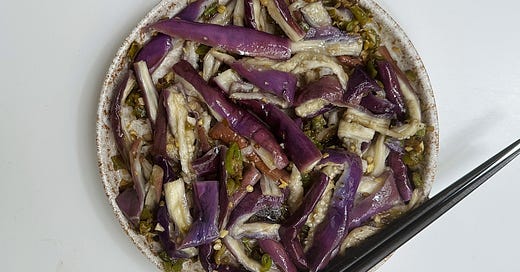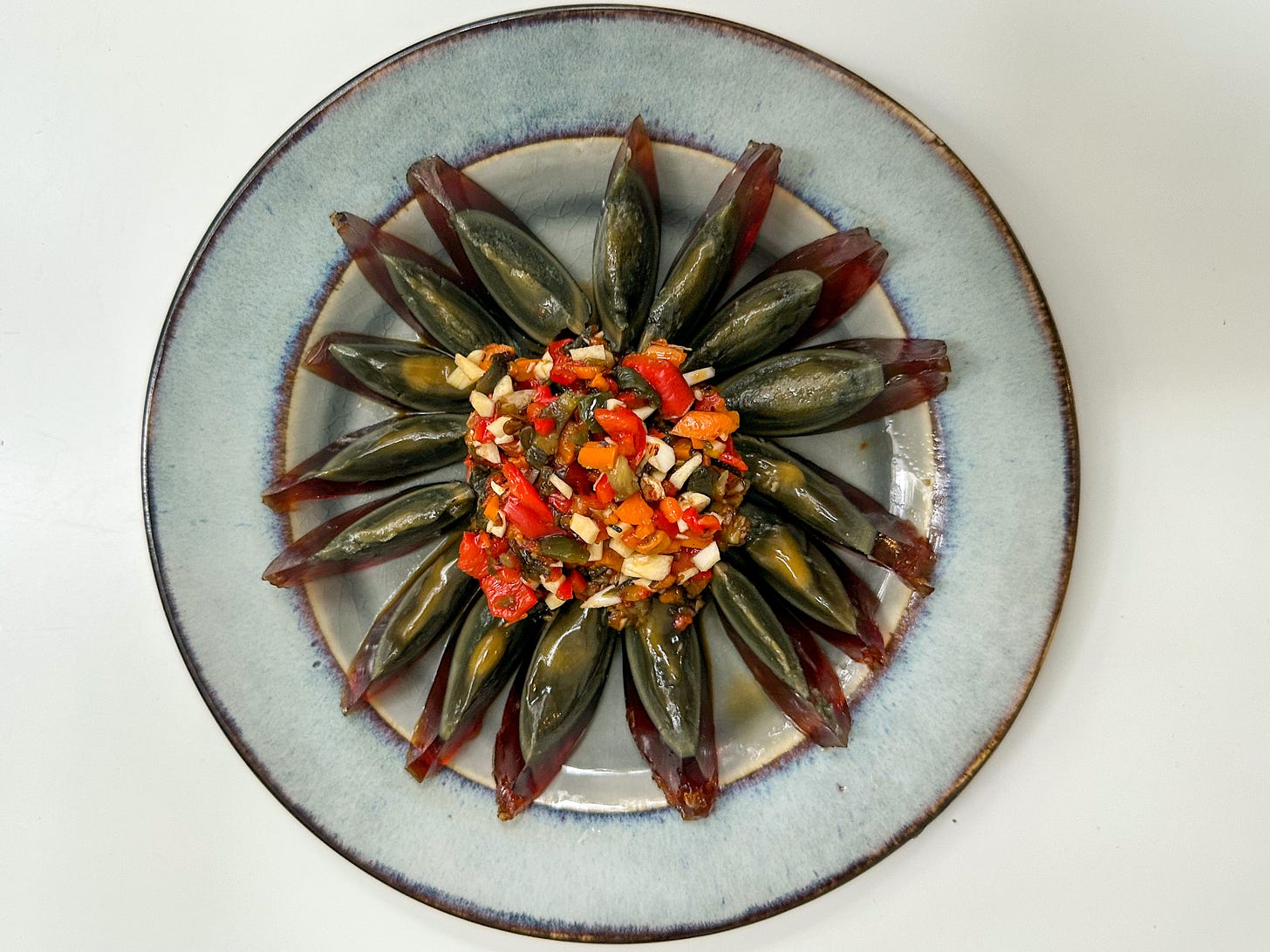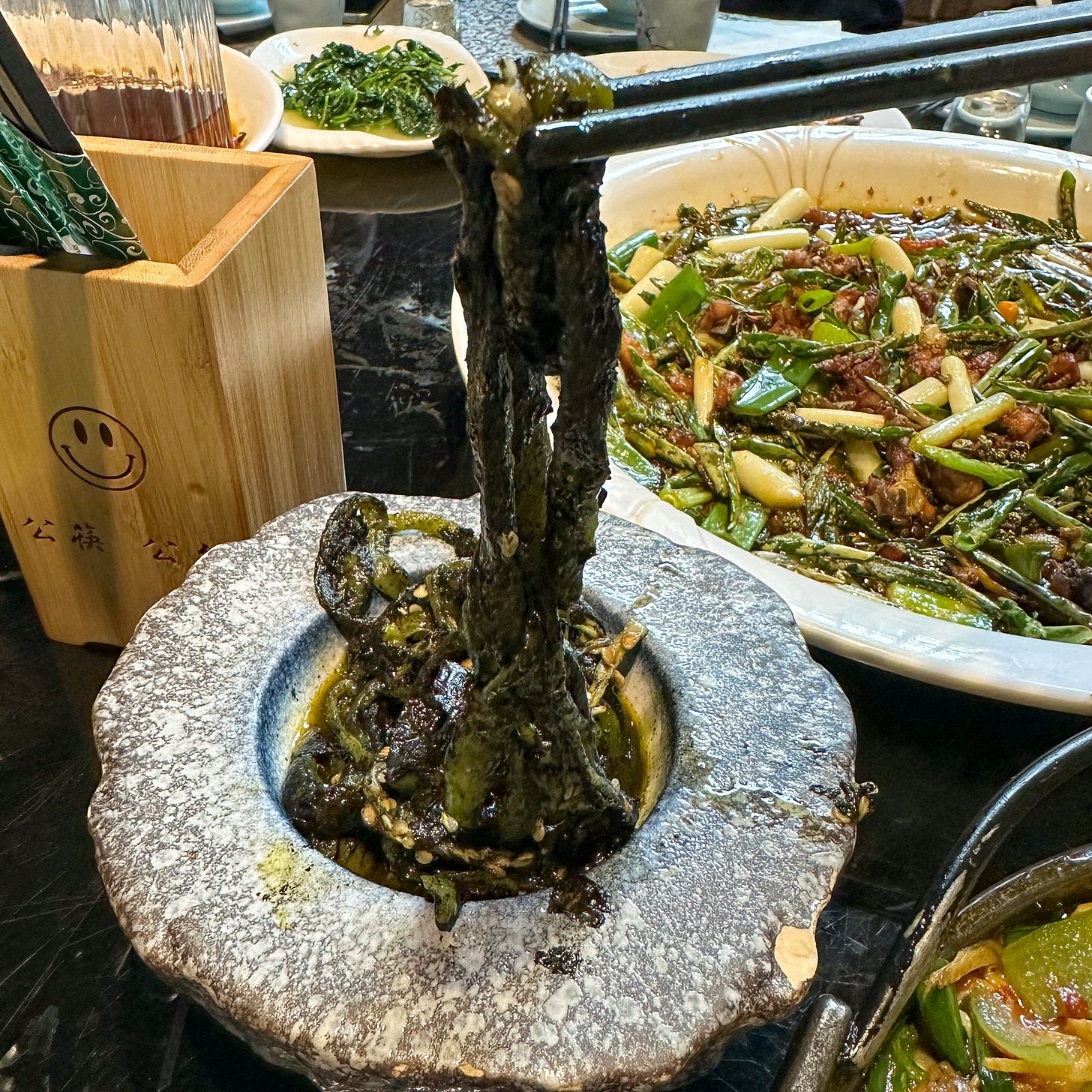Hi! This week we’re cooking a vegetable that I’ve overlooked for so long: eggplants.
I don’t cook eggplants often, or at least not often enough to show my love. This is mostly due to the impression that the only way to make delicious Chinese eggplant dishes is by deep-frying them. What I discovered in the last year was that eggplants are exceptional when steamed. They’re tender but not mushy, making a perfect vehicle to soak up any sauce. For example, this recipe with a charred pepper sauce, which boasts a smoky flavor with a mild spiciness. Shaojiao qiezi (烧椒茄子) is a dish I've savored in restaurants back in Sichuan but never imagined would be so easy to prepare.
Watch me make it here!
The recipe
Servings: 2
2 long eggplants (approx. 300g)
2-3 Turkish long green peppers (approx. 100g)
2 cloves garlic, minced
2 slices ginger, minced
1/2 tbsp soy sauce
1 tsp dark rice vinegar
1/2 tsp salt, and more to taste
2 tbsp vegetable oil
Instructions:
Halve the eggplants length-wise and cut into about 10cm-long pieces.
Microwave the eggplants on a plate with 1 tbsp of water on high heat for 5-7 minutes until soft, then discard the water; or set a steamer on a pot, once steaming, add the eggplants and steam for about 12 min. until soft. After they've cooled down, shred them with your hands into 1-2 cm wide strips.
While the eggplants are cooking, clean the peppers. Heat a pan over medium-high heat, once hot, reduce the heat. Add peppers, dry-roast without oil until they char on most surfaces, turning and pressing down with a spatula until they become deep brown and soft.
Once the peppers have cooled, remove the burnt part (I normally don’t mind) and chop them into small pieces. Add minced garlic and ginger (or chop them altogether in a food processor). Season with soy sauce, vinegar, and salt.
Heat up oil over high heat until hot, pour over the pepper mixture, and mix to combine. Alternatively, you can fry the mixture in the oil for 1 minute. Or skip this step if you don’t mind raw garlic taste, season with sesame oil instead. Serve the charred pepper sauce over eggplants. Enjoy lukewarm or cold!
Tips for cooking the best eggplants
Eggplant tends to lose its color when exposed to heat for a long time, so it's crucial to keep the cooking process as short as possible while ensuring they are properly cooked. To achieve this without deep-frying, here are some tips:
Pick the right eggplants: I tested with speckled purple eggplants from the farmers' market and long Japanese eggplants (or Chinese eggplants). I prefer the latter because they have softer skin, fewer seeds, and brighter color. Opt for firm, bright eggplants without blemishes. If you’re using globe eggplant (the common kind in German supermarkets), peel the skin.
Soak in salted/vinegar water before cooking: soaking the eggplant in water with 1 tsp salt or 1-2 tsp white rice vinegar prevents it from turning brown (read more here).
Steam on the stove: If you're steaming the eggplants with a steamer, make sure is large enough for the steam to circulate, or cook in batches. Steam the eggplants over medium-high heat and take them out immediately once cooked.
Microwave (best method!): I was skeptical about this when first read it on Chinese social media, but it turned out to be a great way to cook eggplant. Adding a dash of water to your plate and covering it with (microwave-safe) plastic wrap or a microwave cover creates a similar effect to steaming.
Of course, if your eggplants don’t turn out as bright purple, it doesn’t mean they’re not tasty!
How to make charred pepper sauce
When red peppers are dried or pickled, and used in condiments, fresh green peppers are generously used in Sichuan cooking. Charred pepper is a preparation with rural origins and is often served with jelly noodles or eggplants. Sometimes, it's mixed with fermented black beans (douchi). The version from the book Dazhong Chuancai (大众川菜, pub 1979) has a recipe with century eggs and only mixes peppers with soy sauce and sesame oil.
烧拌青椒系沿用农村习俗,加入皮蛋拌食,其味别具一格 (《大众川菜》)
translates: charring pepper is a tradition inherited from rural customs, and when combined with century eggs, it has a unique and distinctive flavor.
In rural Sichuan, peppers are typically charred using cooking fires from charcoal or wood stoves. You can replicate them by skewering them and roasting them over a gas stove or using a pan for dry roasting. For a substitute, I used long, thin green chili peppers from a Turkish market (sivri biber), as fresh green erjingtiao is commonly used in Sichuan. However, you can use any non-spicy type, such as shishito peppers. The smaller, longer ones are easier to flip and roast evenly in a pan.
Just like in many other regions around the world, charred peppers are beloved in southern Chinese cuisines, used as both a sauce and the main star of a dish. For instance, in Hunan, they are shredded and pounded with century eggs (lei lajiao, 擂辣椒), or similarly in Yunnan, both eggplants and chilis are charred and pounded together with chili and lime juice (chong qiezi, 舂茄子).
This sauce can be used as a topping for rice and noodles as well.









Made this tonight. Very good! Needed more eggplant, but the sauce was happy to join some rice.